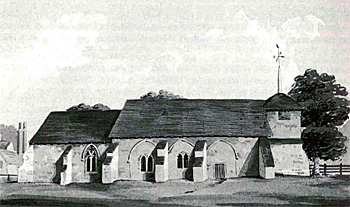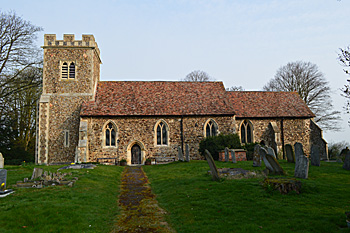Higham Gobion Church Repairs and Alterations

Higham Gobion church by Thomas Fisher about 1815
Most of the structural history of the church can be found in detail in Bedfordshire Historical Record Society Volume number 77 of 1998 Bedfordshire Churches in the Nineteenth Century: Part II: Parishes H to R put together by former County Archivist Chris Pickford from numerous sources some held by Bedfordshire Archives and some held elsewhere or published.
The font dates from the 17th or 18th century. The monument to Rev Edmund Castell (died 1685) is contemporary with him. Probably shortly after Castell's death the medieval north aisle was pulled down and the arcade filled in.
A new pulpit and reading desk were installed in 1814 as were new seats in the nave. It is possible that the plaster ceiling in the nave was introduced at the same time. A barrel organ was installed in 1849.
John Martin (1791-1855) was the opinionated librarian of Woburn Abbey and wrote articles describing Bedfordshire churches in the Northampton Mercury under the pseudonym WA in the years either side of 1850. They are usually an excuse for a rant about the poor state of churches and attitudes of clergy and parish officers. He had a particular aversion to whitewash, ceiled roofs and box pews. Martin wrote about Higham Gobion in the edition of 17th April 1847.
"This is a very small church, and it would, therefore, not be a very expensive affair to restore it to something like a decent appearance. At the time we saw it the plaster was patching up here and there some of the most glaring of the external dilapidations. Of course it is hardly necessary to say that this sovereign remedy is unsparingly used in the interior. It is lavished on the chancel, which has a plastered ceiling, concealing the timber roof. The altar table is a most miserable one, with appropriate railings. Sedilia appear to have been both painted and plastered, and some attempts to scrape off the vile applications have been successful. This quarter appears to be used as a concert-room, for we observed two musical instruments. Delighted as we should be to witness a return to the right performance of our noble service, and chanting restored, we desired it not if obtained by such desecration of the holy temple. The incumbent's residence, occupying a larger space than the church itself, affords a striking and melancholy contrast in every respect. A wretched stove was crowded in here, "Let those black pipes, I entreat you, be removed, and place your stoves where they will not offend the eye" [a quotation from Archdeacon Julius Charles Hare (1795-1855), one of Martin's heroes]
"The nave has a plastered ceiling, which is so contrived as to destroy the apex of the chancel arch. The sittings are modern wooden boxes. Though we agree that "their knell has been rung", yet every opportunity of protesting against them should be embraced, and we avail ourselves of the words of the eloquent and active Archdeacon, already quoted, to enforce the good work "Above all, the tendency to pews is to destroy the character of social worship. Instead of our kneeling side by side, rich and poor one wit hanother, pews keep up those distinctions of rank which, in the presence of God, we should desire to lay aside, each family penning itself up within its high wooden walls, and carefully secluding itself from all contact and communion with its neighbours. Indeed, when one sees a church on a week-day, and sees the strange fashion in which the floor is portioned out into large shapeless boxes, one is involuntarily reminded of one of the ugliest objects on the face of the earth, Smithfield Market when empty".
"In one corner lay decaying laurels, and the refuse of the stove, a dirty and disgraceful sight. The belfry is partly boarded up, but the door was open to afford a view we suppose of the rubbish therein collected. The font has its leaden lining and drain; it is painted. The whole of this small church, which might easily be rendered a fit temple for the service of the Most High, is in a most neglected state. The roof is tiled".
"There is no school and the churchwarden was ignorant of the name of the saint to whom the church was dedicated".
In 1873 Archdeacon of Bedford, Frederick Bathurst, observed that the church as "in a very bad condition" in 1873 [ref: ABV3]. In 1879 and 1880 the church was so heavily restored as to be practically rebuilt. The exterior is almost wholly of this period as is the west tower above the level of the nave roof. The narrow passageway forming the north aisle was built and the 14th century arcade unblocked.
The faculty [ref: P125/2/2/1] states: "removal of ceiling, repair and strengthening the timber of the roof, stripping and relaying tiles, stripping plaster from external walls, repair and pointing up of walls, removal of plaster from internal walls and rendering them with Portland cement, pulling down walling between arcades of the north wall to open out the arcading and build a new north aisle, to partly take down and rebuild the chancel arch, to take down and rebuild the spire, the construction of drains outside the church, repair of all defective windows, to provide a new east window and new windows in the north and south walls, to block up the north doorway to make room for a new window, new tile floors, new pitch pine seats in the nave and new oak seats in the chancel, new pulpit, reading desk and lectern and a new oak porch to the south doorway". Such drastic work was against the advice of the Society for the Preservation of Ancient Buildings.
In 1943 the east end was found to be unsafe, either as a result of, or exacerbated by, the dropping of bombs nearby in 1940. Restoration duly took place after the war. Electric light was installed in 1946 [P125/0/2]. The tower was restored separately in 1969.

Higham Gobion church from the south, April 2015